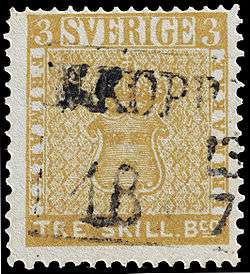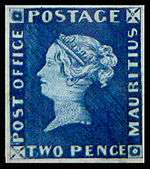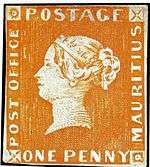Stamp collecting
Stamp collecting is the collecting of postage stamps and related objects. It is related to philately, which is the study of stamps. It has been one of the world's most popular hobbies since the late nineteenth century with the rapid growth of the postal service,[1] as a never-ending stream of new stamps was produced by countries that sought to advertise their distinctiveness through their stamps.
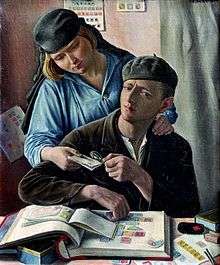
Collecting
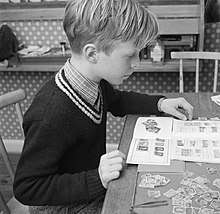
Stamp collecting is generally accepted as one of the areas that make up the wider subject of philately, which is the study of stamps. A philatelist may, but does not have to, collect stamps. It is not uncommon for the term philatelist to be used to mean a stamp collector. Many casual stamp collectors accumulate stamps for sheer enjoyment and relaxation without worrying about the tiny details. The creation of a large or comprehensive collection, however, generally requires some philatelic knowledge and will usually contain areas of philatelic studies.
Postage stamps are often collected for their historical value and geographical aspects and also for the many subjects depicted on them, ranging from ships, horses, and birds to kings, queens and presidents.[2]
Sales of postage stamps are an important source of income for some countries whose stamp issues may exceed their postal needs, but have designs that appeal to many stamp collectors.
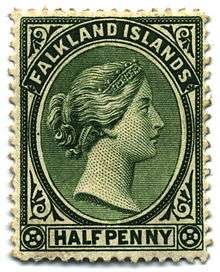
History
It has been suggested that John Bourke, Receiver General of Stamp Dues in Ireland, was the first collector. In 1774 he assembled a book of the existing embossed revenue stamps, ranging in value from 6 pounds to half a penny, as well as the hand stamped charge marks that were used with them. His collection is preserved in the Royal Irish Academy, Dublin.[3]
Postage stamp collecting began at the same time that stamps were first issued, and by 1860 thousands of collectors and stamp dealers were appearing around the world as this new study and hobby spread across Europe, European colonies, the United States and other parts of the world.
The first postage stamp, the Penny Black, was issued by Britain in May 1840 and pictured a young Queen Victoria. It was produced without perforations (imperforate) and consequently had to be cut from the sheet with scissors in order to be used. While unused examples of the Penny Black are quite scarce, used examples are quite common, and may be purchased for $20 to $200, depending upon condition.
People started to collect stamps almost immediately. One of the earliest and most notable was John Edward Gray. In 1862, Gray stated that he "began to collect postage stamps shortly after the system was established and before it had become a rage".[4]
Female stamp collectors date from the earliest days of postage stamp collecting. One of the earliest was Adelaide Lucy Fenton who wrote articles in the 1860s for the journal The Philatelist under the name Herbert Camoens.[5]
As the hobby and study of stamps began to grow, stamp albums and stamp related literature began to surface, and by the early 1880s publishers like Stanley Gibbons made a business out of this advent.
Children and teenagers were early collectors of stamps in the 1860s and 1870s. Many adults dismissed it as a childish pursuit but later many of those same collectors, as adults, began to systematically study the available postage stamps and publish books about them. Some stamps, such as the triangular issues of the Cape of Good Hope, have become legendary.
By the early 2000's stamp collecting was seen to be in decline as the digital world surpassed traditional hobbies even though by 2013, The Wall Street Journal estimated the global number of stamp collectors was around 60 million.[6]
Modern Collecting
In 2016 the American Philatelic Society released a paper on the Future of Philately. It suggested that many collectors were 'hidden.' This meant that people would collect at home but not necessarily associate themselves with a traditional stamp club. A challenge for these clubs was to connect with this hidden community. One of the major players in this role was Graham Beck of Exploring Stamps. Exploring Stamps was a three season YouTube channel exploring stamps in a modern light. It was a break-through series that connected with many hidden collectors due to the quality and freshness of the content. Beck's work spawned a number of new quality channels including Stamps with Sara, Ted Talks Stamps and Philately Dad.
In April, 2020 James Gavin of the Rhodesian Study Circle presented the Future of Philately talk with the American Philatelic Society's Stamp Chat series on YouTube. In this talk, the concept of Traditional and Modern collectors was discussed. The Traditional collector (those born prior to 1970s) was outlined as those who preferred paper publications, attending stamp meetings in person and were more focused on the technical aspects of the hobby. Modern collectors (those born after the 1970s) on the other hand, interacted through social media platforms, relied on digital publications, and were more focused on the presentation and exploration of the subjects of stamps. The purpose of the talk was to help stamp clubs modernise their websites from relics of the 1990's to 2020 standards, removing old practices such as paper application forms, outdated HTML designs and dated content.
Those clubs that have begun to modernise the hobby have seen growth in their membership. The Korea Stamp Society, on the brink of closure, went to a completely digital format and moved to free membership. They were able to see massive growth in their membership as a result. Following closely was the Spanish Philatelic Society, which also went to free membership. The Rhodesian Study Circle began updating its website in 2015 and established itself as a leader for how societies can deliver a new approach to collecting. They differ by mixing history with stamps. This approach was recommend in the American Philatelic Society's Future of Philately paper based on information from the Smithsonian National Postal Museum.
During the COVID-19 lockdown, many societies moved to Zoom to interact with their members. The American Philatelic Society was the most active during this period with their Stamp Chat series, often inviting influential philatelists to make presentations on a variety of topics. In October 2020, Stampex International will hold one of the first virtual stamp shows, with exhibitors and dealers making virtual appearances.
Equipment
A few basic items of equipment are recommended for proper stamp collection. Stamp tongs help to handle stamps safely, a magnifying glass helps in viewing fine details and an album is a convenient way to store stamps. The stamps need to be attached to the pages of the album in some way, and stamp hinges are a cheap and simple way to do this. However, hinging stamps can damage them, thus reducing their value; today many collectors prefer more expensive hingeless mounts. Issued in various sizes, these are clear, chemically neutral thin plastic holders that open to receive stamps and are gummed on the back so that they stick to album pages. Another alternative is a stockbook, where the stamps drop into clear pockets without the need for a mount. Stamps should be stored away from light, heat and moisture or they will be damaged.
Stamps can be displayed according to the collector's wishes, by country, topic, or even by size, which can create a display pleasing to the eye. There are no rules and it is entirely a matter for the individual collector to decide. Albums can be commercially purchased, downloaded or created by the collector. In the latter cases, using acid free paper provides better long-term stamp protection.
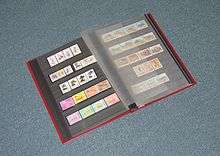 A stockbook with clear plastic pockets is one of the safest ways to store stamps. Some collectors prefer a traditional stamp album.
A stockbook with clear plastic pockets is one of the safest ways to store stamps. Some collectors prefer a traditional stamp album.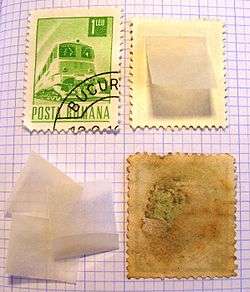 Clockwise from top left: hinge-mounted stamp, stamp about to be hinge-mounted, stamp damaged by a hinge, stamp hinges.
Clockwise from top left: hinge-mounted stamp, stamp about to be hinge-mounted, stamp damaged by a hinge, stamp hinges.
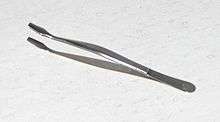 Stamp tongs with rounded tips help to prevent damage to stamps from skin oils and rough handling
Stamp tongs with rounded tips help to prevent damage to stamps from skin oils and rough handling
Acquiring stamps
Many collectors ask their family and friends to save stamps for them from their mail. Although the stamps received by major businesses and those kept by elderly relatives may be of international and historical interest, the stamps received from family members are often of the definitive sort. Definitives seem mundane but, considering their variety of colours, watermarks, paper differences, perforations and printing errors, they can fill many pages in a collection.[7] Introducing either variety or specific focus to a collection can require the purchasing of stamps, either from a dealer or online. Online stamp collector clubs often contain a platform for buying/selling and trading.[8] Large numbers of relatively recent stamps, often still attached to fragments or envelopes, may be obtained cheaply and easily. Rare and old stamps can also be obtained, but these can be very expensive.
Duplicate stamps are those a collector already has and are not required, therefore, to fill a gap in a collection. Duplicate stamps can be sold or traded, so they are an important medium of exchange among collectors.
Many dealers sell stamps through the Internet while others have neighborhood shops which are among the best resources for beginning and intermediate collectors. Some dealers also jointly set up week-end stamp markets called "bourses" that move around a region from week to week. They also meet collectors at regional exhibitions and stamp shows.
Collecting specialties
A worldwide collection would be enormous, running to thousands of volumes, and would be incredibly expensive to acquire. Many consider that Count Philipp von Ferrary's collection at the beginning of the 20th century was the most complete ever formed. Many collectors limit their collecting to particular countries, certain time periods or particular subjects (called "topicals") like birds or aircraft.
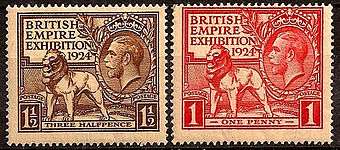
Some of the more popular collecting areas include:
- Postage stamps – particular countries and/or time periods
- Airmail stamps – stamps may be required for airmail, which is typically more expensive and has special postage rates.
- Commemorative stamps – stamps to commemorate events, anniversaries, etc., on sale for a limited time.
- Definitive stamps – the most common type of stamps
- Postage due stamps are special stamps applied by a post office to mail bearing insufficient postage. The stamps were issued in several denominations to make up different amounts due.
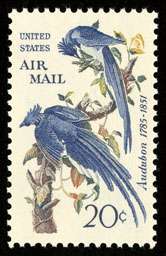
- Topical stamp collecting – many collectors choose to organize their philatelic collection on the theme of the stamps, covers, or postmarks. Popular topical themes are animals, dogs, cats, butterflies, birds, flowers, art, sports, Olympics, maps, Disney, scouting, space, ships, Americana (topics relating to the US), stamps on stamps, famous people, chess, Chinese new year, and many others.
- Birds on stamps
- Ships on stamps
- Insects on stamps
- People on stamps
- Stamps on stamps
- Postal stationery – includes government-issued postal cards, aerograms, letter card, wrappers, envelopes, etc., that have an imprinted stamp.
- Sheets
- Sheetlets – this is a format that is now issued regularly by postal administrations. Instead of issuing stamps in large sheets of 40, 100 or even 200 stamps, smaller sheetlets with 20 to 24 stamps are issued with a large selvedge area which may incorporate part of the stamp design or theme.
- Souvenir sheets – many postal services sometimes release stamps in a format that look like a sheet with a big picture. Various parts of the picture can be torn out and used as postage stamps. See example with 10 stamps in one picture. (Souvenir sheets should be distinguished from souvenir cards, which are souvenirs of a philatelic meeting or exhibition but are not valid for postage.)
- Miniature sheet – is very similar to a souvenir sheet, being in a sheetlet with a single or a number of stamps embedded in it.
- Corner blocks or plate blocks – compose a block of stamps from one of the four corners of the stamp sheet. Collectors usually opt for a block of four stamps, complete with the selvage area which will sometimes have the printing details on it.
- Coil strips – Pairs or more of stamps from rolls, premium ones showing the plate number or a coil line pair which shows the seam between the edges of the plate.
- Revenue stamps – stamps issued to pay taxes.
- Federal Duck Stamps (stamps for duck hunting licenses, mainly U.S. with some other countries such as Canada and New Zealand)
- First day cover (FDCs) – envelopes with stamps attached and canceled on the first day that the stamp was issued. Most modern FDCs bear designs, called "cachets", related to the theme of the stamp issued.
- Maximum cards – these are postcards where the stamp is on the same side as the picture and they have a close connection.
- Souvenir pages – with first day canceled stamps on a page describing all design, printing and issuing details. These are similar to first day covers except that they are issued as printed sheets of paper instead of envelopes, and the specification of the stamp is printed by the official source. See picture of first souvenir page in the US.
- Cinderella stamps – stamp-like labels that are not valid for postage.
- Postmarks or postal markings in general.
Organizations
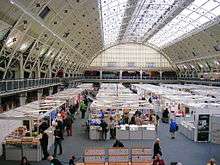
There are thousands of organizations for collectors: local stamp clubs, special-interest groups, and national organizations. Most nations have a national collectors' organization, including the American Philatelic Society (APS) in the United States; the Royal Philatelic Society London and Philatelic Traders Society in United Kingdom; and the Royal Philatelic Society of Canada in Canada. The Internet has greatly expanded the availability of information and made it easier to obtain stamps and other philatelic material. The American Topical Association is now a part of the APS and promotes thematic collecting as well as encouraging sub-groups of numerous topics.
Stamp clubs and philatelic societies can add a social aspect to stamp collecting and provide a forum where novices can meet experienced collectors. Although such organizations are often advertised in stamp magazines and online, the relatively small number of collectors – especially outside urban areas – means that a club may be difficult to set up and sustain. The Internet partially solves this problem, as the association of collectors online is not limited by geographical distance. For this reason, many highly specific stamp clubs have been established on the Web, with international membership.[9]
Organizations such as the Cinderella Stamp Club (UK) retain hundreds of members interested in a specific aspect of collecting. Social organizations, such as the Lions Club and Rotary International, have also formed stamp collecting groups specific to those stamps that are issued from many countries worldwide that display the organization's logo.
Rare stamps
Rare stamps are often old and many have interesting stories attached to them. Some include:
- The British Guiana 1c magenta is the world's most famous and valuable rare stamp.
- The United States "Inverted Jenny" (which is actually a printing error)
- The United States "1-cent Z grill" stamp
- The Treskilling Yellow
- The Mauritius "Post Office" stamps
- The British Penny Red plate 77
Some of the most valuable stamps in the world
Catalogues
Stamp catalogues are the primary tool used by serious collectors to organize their collections, and for the identification and valuation of stamps. Most stamp shops have stamp catalogues available for purchase. A few catalogues are offered online, either free or for a fee. There are hundreds of different catalogues, most specializing in particular countries or periods. Collector clubs tend to provide free catalogues to their members.
Notable collectors
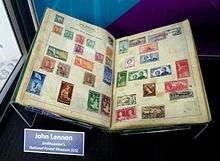
The stamp collection assembled by French-Austrian aristocrat Philipp von Ferrary (1850–1917) at the beginning of the 20th century is widely considered the most complete stamp collection ever formed (or likely to be formed). It included, for example, all of the rare stamps described above that had been issued by 1917. However, as Ferrary was an Austrian citizen, the collection was broken up and sold by the French government after the First World War, as war reparations. A close rival was Thomas Tapling (1855–1891), whose Tapling Collection was donated to the British Museum.
Several European monarchs were keen stamp collectors, including King George V of the United Kingdom and King Carol II of Romania. King George V possessed one of the most valuable stamp collections in the world and became President of the Royal Philatelic Society. His collection was passed on to Queen Elizabeth II who, while not a serious philatelist, has a collection of British and Commonwealth first day covers which she started in 1952.[12]
U.S. President Franklin Delano Roosevelt was a stamp collector; he designed several American commemorative stamps during his term.[13] Late in life Ayn Rand renewed her childhood interest in stamps and became an enthusiastic collector.[14] Several entertainment and sport personalities have been known to be collectors. Freddie Mercury, lead singer of the band Queen, collected stamps as a child. His childhood stamp album is in the collection of the British Postal Museum & Archive.[15] John Lennon of The Beatles was a childhood stamp collector. His stamp album is held by the National Postal Museum.[16]
Former world chess champion Anatoly Karpov has amassed a huge stamp collection over the decades, led by stamps from Belgium and Belgian Congo, that has been estimated to be worth $15 million.[17]
References and sources
- Notes
- Vickers, Marcia (15 December 1996). "Delivery Isn't Guaranteed, but Stamps Are Turning Profits". The New York Times. Retrieved 10 December 2009.
- "What is stamp collecting?". Learn About Stamps. 2010. Retrieved 4 October 2010.
- "The origin of stamp collecting in America, Part 1". Linn's Stamp News. 17 October 2014. Retrieved 15 July 2017.
- Gray, John Edward, A Hand Catalogue of Postage Stamps for the use of the Collector, 1862, Robert Hardwicke, page viii
- The American Philatelist, Volume 75, p.32
- "Graph: The Wide World of Stamps". WSJ.MONEY. 2013. Archived from the original on 28 October 2014. Retrieved 24 September 2013.
- Klug, Janet (2012). "A limited budget can still mean unlimited fun". Linns Stamp News. Retrieved 11 May 2012.
- "Stamps on Colnect". colnect.com. Retrieved 30 March 2019.
- "Stamp Clubs And Philatelic Societies". Stamphelp.com. Retrieved 25 October 2008.
- "Rare stamp sells for record price in Geneva auction". BBC News. 22 May 2010. Retrieved 24 May 2010.
- Feldman, David (1993), Prices Realised for Public Auction November 1-6 November 1993, Prces Realised, Zurich: David Feldman, p. 1
- Courtney, Nicholas. The Queen's Stamps – The Authorised History of the Royal Philatelic Collection. London: Methuen, 2004, p.303. ISBN 0-413-77228-4
- "FDR–Stamp Collecting President". National Postal Museum. Retrieved 7 February 2010.
- "Why I Like Stamp Collecting", Minkus Stamp Journal, 1971 , cf. "The new Ayn Rand companion", Mimi Reisel Gladstein, p. 130, Greenwood Publishing Group, 1999, ISBN 0-313-30321-5
- "Famous Philatelists". The British Postal Museum & Archive. Retrieved 24 July 2009.
- "John Lennon – The Lost Album". National Postal Museum. Retrieved 24 July 2009.
- Anatoly Karpov Belgian stamp collection offered at David Feldman, justcollecting.com, 2015.
- Sources
- Cabeen, Richard McP. (1979). Standard Handbook of Stamp Collecting. Chicago: Collectors Club of Chicago. ISBN 0-690-01773-1.
- Nankivell, Edward J. (2007). Stamp Collecting as a Pastime: Stanley Gibbons Philatelic Handbooks (1902). UK: Dodo Press. ISBN 1-4065-3058-1. Free download here.
Further reading
- Klug, Janet. Guide to Stamp Collecting. Smithsonian/Collins. ISBN 0061341398 (Children's/Young Adult)
- Watson, James. How to start Stamp Collecting. London; Stanley Gibbons. ISBN 0852596170 (Adult beginner)
- Phillips, Stanley. Stamp Collecting: A guide to modern philately. Revised edition. London: Stanley Gibbons, 1983. ISBN 0-85259-047-4 (Adult beginner, more detailed but a little out of date)
External links
| Wikimedia Commons has media related to Philately. |
- LearnAboutStamps.com A resource for stamp collectors
- PhilaTalk.com A stamp collector forums
- Caring for stamps and postal history British Postal Museum & Archive Information Sheet
- Philatelic Dictionary English – German – French
- StampNews.com Provides updates on new stamp issues and stamp collecting from around the world.
- Stamp Story, a 1955 information film about stamp collecting.
